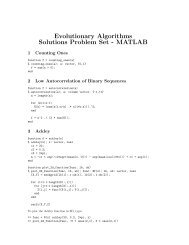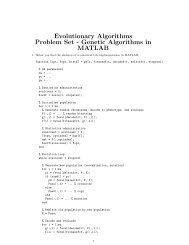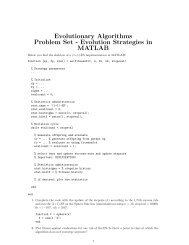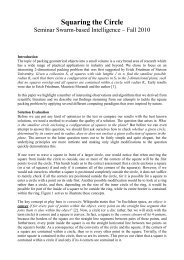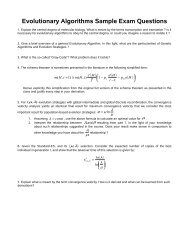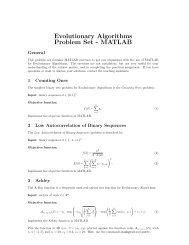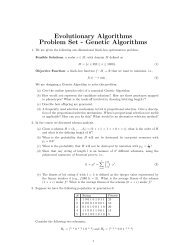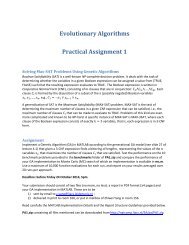Evolutionary Algorithms Practical Assignment 2 - Liacs
Evolutionary Algorithms Practical Assignment 2 - Liacs
Evolutionary Algorithms Practical Assignment 2 - Liacs
You also want an ePaper? Increase the reach of your titles
YUMPU automatically turns print PDFs into web optimized ePapers that Google loves.
<strong>Evolutionary</strong> <strong>Algorithms</strong><br />
<strong>Practical</strong> <strong>Assignment</strong> 2<br />
Real-Valued Optimization Using Evolution Strategies<br />
In this <strong>Practical</strong> <strong>Assignment</strong> you are presented with a Large-Scale Multi-Disciplinary Mass<br />
Optimization in the Auto Industry. This problem consists of a function with real-valued input<br />
parameters that is to be minimized:<br />
f(x)min, x in R N<br />
subject to 0 ≤ x i ≤ 1, for all i in{1,…,N}<br />
with N = 124 (i.e., a 124-dimensional search space)<br />
and 68 inequality constraints of form g i (x) ≤ 0. ( g i (x) > 0 means the constrain is violated)<br />
The aim of this problem is to find the best solution which can minimize the fitness value and also<br />
violate less constrains. The problem can be found in the file PA2.zip, to be downloaded from<br />
http://natcomp.liacs.nl/EA/pa/PA2.zip.<br />
<strong>Assignment</strong><br />
Implement an Evolution Strategy (ES) in MATLAB using (µ +/, λ)-selection to optimize these<br />
problems. The choice between plus or comma selection can be made beforehand, or depending on<br />
what you discover to deliver the best results w.r.t. the given optimization problems. Your algorithm<br />
should be able to operate on arbitrary values of µ and λ.<br />
Describe your implementation by means of pseudocode, accompanied by a textual explanation,<br />
providing the possibility for the reader to easily re-implement the ES exactly as you did and recreating/verifying<br />
your results. Report on the performance of your algorithm, presenting the average<br />
performance over 10 runs on the test problems, using a budget of 2,000 function evaluations.<br />
Please note, because it is not easy to get a feasible improvement for this problem, 3 violations of<br />
constrains is allowed and the final formula we used to compare your results is:<br />
F = f(x) + 2 * number of (g i (x) > 0).<br />
Deadline: before Friday 5 December 2014, 5pm.<br />
Your submission should consist of two files (no more, no less): a report in PDF format (≥4 pages) and<br />
the ES implementation in MATLAB. These are to be
1) sent by email to z.yang@liacs.leidenuniv.nl ;<br />
2) delivered in print to room 160, or put in mailbox of Zhiwei Yang in room 156.<br />
Read carefully the MATLAB Implementation Details and the Report Structure Guidelines provided<br />
below.
MATLAB Implementation Details<br />
Your ES implementation should consist of one .m file named lastname1_lastname2_es.m (replacing<br />
lastname1 and lastname2 by your own names) and should be structured as follows:<br />
function [xopt, fopt, gopt] = lastname1_lastname2_es(fitnessfct, N,<br />
lb, ub, eval_budget)<br />
…<br />
end<br />
Here, fitnessfct is a handle to the fitness function, N denotes the dimensionality of the input to<br />
fitnessfct, lb is an N-dimensional row vector of lower bounds, ub is an N-dimensional row vector of<br />
upper bounds, and eval_budget denotes the function evaluation budget; xopt is the best solution<br />
found, fopt the accompanying best fitness value and gopt the accompanying best constrains.<br />
The mopta08 fitness function is of the following form:<br />
[f, g]= mopta08 (x)<br />
…<br />
End<br />
Where f is the fitness and g is a vector of constrains.<br />
For windows and linux, we have different versions of mopta08.exe and mopta08.m. You can see it<br />
from the PA2.zip. The input.txt and output.txt are used for the evaluation function.<br />
The implementation should start from the start point given by start.txt.<br />
To run your ES on mopta08 with N=124, lb=[0] N , ub = [1] N , and a budget of 2000 function evaluations<br />
you type<br />
[xopt, fopt, gopt] = lastname1_lastname2_es(@mopta08, 124,<br />
zeros(1,124), 1 * ones(1,124), 2000)<br />
The mopta08 functions expect an N-dimensional row vector x as input (i.e., a vector with a single<br />
row and N columns).<br />
We will compare all submissions using an automated script, this requires all plotting, printing to the<br />
command line etc. to be disabled in the submitted version of your work! Submit one ES, and<br />
configure it to the tested settings that you found to perform best.
Report Structure Guidelines (≥4 pages)<br />
Title + Authors (names, email addresses, and student numbers)<br />
Introduction<br />
Introduction text here.<br />
Problem Description<br />
Brief description of the optimization problem here.<br />
Implementation<br />
Outline of your algorithm, algorithm parameters, and settings used for those parameters. Make sure<br />
that the algorithm and the results are reproducible from your description.<br />
Experiments<br />
Description of the experiments and the results. Use the following tables and figures to report on the<br />
results:<br />
ES configuration A ES configuration B<br />
Benchmark Avg Std dev Avg Std dev<br />
1<br />
2<br />
3<br />
4<br />
5<br />
Table 1: Final solution quality after 10,000 function evaluations, averaged over 20 runs<br />
Performance on Benchmark Problem 1<br />
Best Fitness Score<br />
Algorithm 1<br />
Algorithm 2<br />
1000 2000 3000 4000 5000 6000 7000 8000 9000 10000<br />
Function evaluations<br />
Figure 1: Algorithm convergence, averaged over 20 runs<br />
Make sure to present your results in a way that is convenient to the reader, do not blindly include<br />
plots of all your experiments, try to combine data in figures!<br />
Discussion and Conclusion<br />
Summarize the results and conclude your report.



